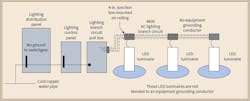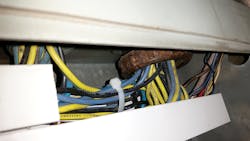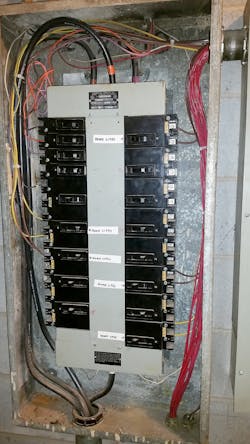The Importance of Grounding — Part 2
Before the days of electronic loads, equipment grounding conductors (EGCs) were not required at the branch circuit level. But with the advent of electronic-based ballasts for fluorescent and HID luminaires, EGCs — now required by the National Electrical Code (NEC) — act as a path for low- and high-frequency currents that the ballasts do not need, or better said, that the ballasts reject. These currents are made up of leakage currents, emissions currents, and disturbance currents.
Leakage currents are currents that “leak” through from the electronic components back to the ground plane of the ballast. Some leakage current flows from the electromagnetic interference (EMI) filter back to the equipment ground (e.g., metal can of the ballast) and seek Earth.
Emissions currents are actually part of the leakage currents. However, they are a result of the EMI filtering action that flows through the EMI filter components connected to the AC line (two AC lines in the case of ballasts powered by two AC line phases) and neutral (in the case of the ballast requiring a neutral conductor — for example, 120V applications).
Disturbance currents are another matter and must be well-managed to keep them from flowing through the ground plane of the ballast, which the electronic components rely on to “preserve” their equipotential ground plane of reference (EGPR). If the EGPR is not kept relatively clean of ground currents, especially disturbance currents, then the electronic components become “confused.” When this occurs, the probability of electronic component failure increases.
Not surprisingly, all of this is applicable to electronic-based LED lighting systems where one or more LED drivers are used. Leakage currents, emissions currents, and disturbance currents must have a place to go (i.e., they must be “allowed” to “easily” flow out of the electronic driver). Managing these grounding currents also helps extend the life of the driver.
How does the quality of the EGC play a vital role in doing this for LED-based lighting systems? First of all, the EGC has to exist in the AC branch circuit. This allows the driver to have access to it. In fact, this is a major problem for older facilities where EGCs were not required in the lighting branch circuits.
The Figure above illustrates a typical installation in an older facility where 480V lighting branch circuits were originally installed to power a traditional HID-based lighting system. When a new electronic lighting control system was installed, it was grounded to the lighting distribution panel (LDP), which was part of the original installation. The LDP uses no grounding conductor back to the main switchgear. The LDP relies on established ground from a nearby cold copper water pipe. A ground conductor does exist from the LDP to the lighting control panel. However, no EGCs exist from the lighting branch circuit pull box (Photo 1) to the individual junction boxes mounted on the ceiling.
With this installation, the LED luminaires have to rely on the “grounded” electrical metallic conduit (EMT) system, which provides protection for the AC lighting branch circuits. The system is bonded to the lighting branch circuit pull box. However, EMT contains many mechanical joints. These joints rely on EMT fittings, which use compression rings and set screws to mechanically secure them in place. These joints do not establish a low-impedance bond between individual sections of EMT. The joints and fittings also do not establish a low-impedance connection with the lighting pull box or the lighting control panel. Regardless of how good the bond to the cold copper water pipe is, the impedance the LED luminaires see back to Earth is very poor.
In this era of electronic-based loads, which must sink leakage currents, emissions currents, and disturbance currents back to a low-impedance point (or Earth), this lighting installation cannot provide the low-impedance ground path to sufficiently ensure the LED drivers are protected from damage caused by electrical disturbances in a facility with poor power quality (i.e., facilities that use switching devices in their power systems and other electronic loads like variable-frequency drives). Electronic loads draw harmonics currents and are susceptible to transient voltages that cause transient currents to flow into the loads when their electronics are not properly protected. In these installations, it’s not the harmonic currents that are causing the problems. It is the emissions currents and disturbance (or transient) currents that are causing damage to the LED drivers when they cannot make it back to Earth through a facility’s electrical system, which relies on the metal/mechanical system of EMT to provide adequate low-impedance and high-frequency grounding back to Earth.
Again, it’s the laws of physics that are broken here. Electronic-based LED lighting equipment requires a high-performance bonding and grounding system to operate in electrical environments where electrical disturbances are a part of the normal common everyday electrical system.
Keebler is a senior power quality engineer and power systems consultant at Electrotek Concepts, Inc. in Knoxville, Tenn. He can be reached at [email protected].
About the Author
Philip Keebler
Senior Power Quality Engineer
Philip F. Keebler, MSEE has 32 years of experience in power quality (PQ) having worked for North American Philips, Electric Power Research Institute (EPRI), Electrotek Concepts & Dranetz. His experience spans across the utility revenue meter addressing PQ problems on the grid and inside residential, commercial and industrial customer facilities. His specialty areas include grounding, disturbances, harmonics, electromagnetic interference (EMI), equipment immunity, PQ monitoring, training and standards development. He serves as a Technical Advisor to PBE Engineers, LLC focused on understanding, identifying, solving and preventing (UISP) PQ problems in the industry and fostering new interest and workforce development to attract young engineers to developing careers in PQ. He can be reached at [email protected].



